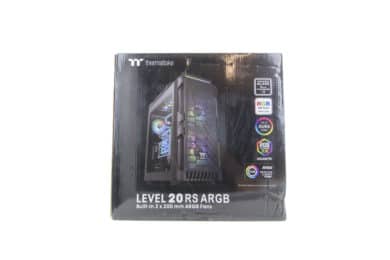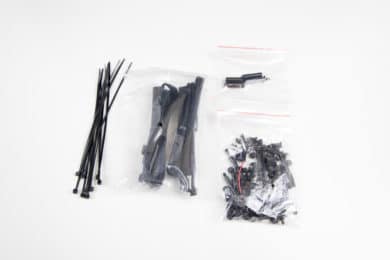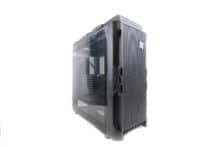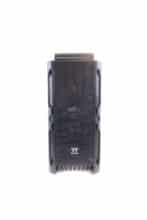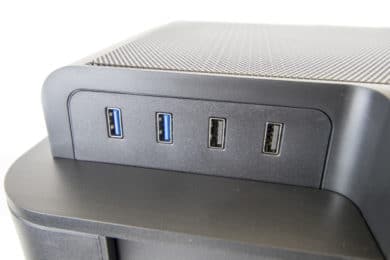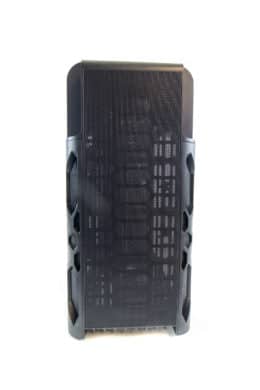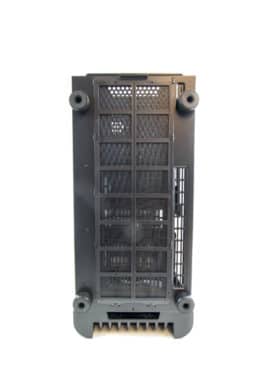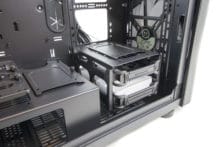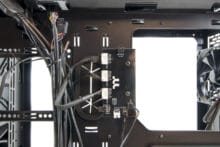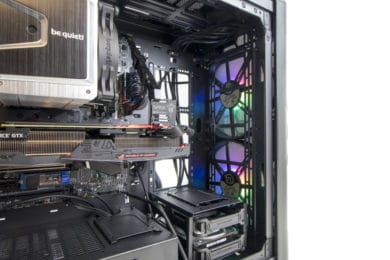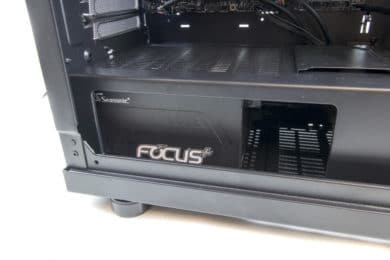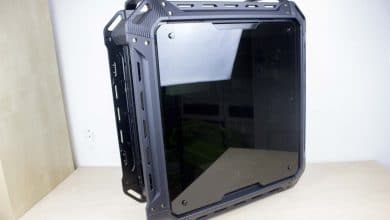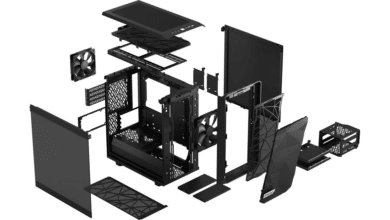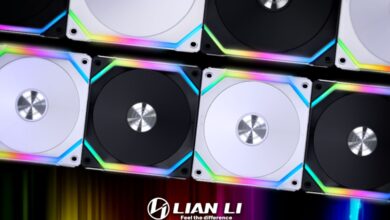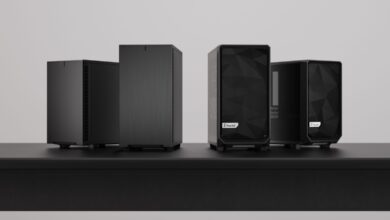
The Thermaltake Level 20 RS ARGB is said to be inspired by a sports car and therefore its ARGB light bar at the front emulates the rear light of a car. We don’t see any similarities and we also wonder – a tail light at the front? But well, storytelling is trendy and so Thermaltake also dared to do it.
With ARGB lighting, tempered glass side panels, a removable power supply cover, a patented PCI-E slot design, and some other features, the case sounds interesting and we took a closer look. In the following you will find out if the € 104.90 * expensive Thermaltake Level 20 RS ARGB midi tower is worth buying.
Technical details
| Model: | Thermaltake Level 20 RS |
| Case type: | Midi Tower |
| Dimensions: | 240.8 mm (W) x 524 mm (H) x 553 mm (D) |
| Weight: | 12.23 kg |
| Material: | Steel, plastic, hard glass |
| Color: | black |
| Front connectors: | 2x USB 3.0, 2x USB 2.0, 1x audio input, 1x audio output, power button, reset button (alternative for RGB control) |
| Drive bays: | 2x 3.5″/ 2.5″ (in hard disk cage) 2x 2.5″ (on the hard disk cage & the power supply cover) 1x 3.5″/ 2x 2.5″ (behind mainboard) |
| Expansion slots: | 8x horizontally or vertically |
| Form factors: | ATX, mATX, mini-ITX |
| Fans: | front: 3x 120 mm, 3x 140 mm or 2x 200 mm (pre-installed, RGB-illuminated) Rear: 1x 120 mm (pre-installed) Cover: 3x 120 mm, 2x 140 mm or 1x 200 mm |
| Radiators: | front: 1x 360 / 280 mm Cover: 1x 360 / 280 mm Rear: 1x 120 mm Next to the mainboard (without hard disk cage:) 1x 360 mm |
| Max. CPU cooler height: | 172 mm |
| Max. graphic card length: | 400 mm (282 mm with hard disk cage) |
| Max. Power supply unit length: | 220 mm |
| Place for cable management: | 37 mm |
| Space for front radiator: | max. 28 mm (with hard disk cage) |
| Price: | € 104.90 * |
| Special features: | dust filter, cable management, RGB light strips, glass side panels, vertical graphics card holder, pre-mounted (RGB) fans |

Scope of delivery
The Thermaltake Level 20 RS ARGB is delivered in a huge cardboard box, but the case is also huge. Due to its size it can hardly be called a midi tower. The box is extensively designed and already offers a first taste. Inside the case is well and safely stored in styrofoam. Of course there is also a protective foil for the glass side parts.
The accessories are located in the hard drive cage in a white cardboard box. Besides numerous screws, a speaker, a few cable ties and mainboard connection cables for RGB lighting are included. The spacers for the mainboard are pre-installed, just like the RGB fans, so that you can start installing the hardware immediately.
External impression
Even from the outside it is clear: The Level 20 RS ARGB is an Airflow monster. The front has the same large area of mesh grid as the lid. Both can be easily removed with a jerk and are not connected to the I/O panel, so you don’t have to worry about tearing off cables.
In addition to the two large 200 millimeter fans, there is also an RGB strip on the front. The lighting is digitally addressable, so it can display several colours at the same time.
The I/O panel of the Level 20 RS ARGB is a bit special. So the USB ports (2x USB 2.0, 2x USB 3.0) are located on the right side. USB-C is not used. The Power and RGB buttons are located on the left side together with the audio connections. For some people this might be a point of criticism, but I think it’s not badly implemented. Thus, one does not have the unattractive USB sticks or cables directly in the field of vision. But because the I/O panel is recessed, there is still enough space between the USB port and the wall (if you let the case face the wall with the right side) to accommodate a USB stick. So the case doesn’t have to be moved away from the wall because of the USB ports.
The side panels are made of 4 millimetre thick tempered glass and are correspondingly heavy. But they are not the only ones that contribute to the weight, so that the case weighs a proud 12.23 kg. The side panels are only hooked in and fixed at the back with knurled screws, so they can be removed quickly and easily.
The bottom of the housing is also largely open to provide good airflow. There is also a dust filter here – unfortunately it is the only one. Thus, there are none in the front and on the upper side.
Interior impression
The interior of the Level 20 RS ARGB offers numerous design options. As is now customary, the housing is divided into two chambers. Thus, the power supply unit is separated from the remaining components by a cover. However, the hard disk cage isn’t located underneath it as well, but is placed next to it. The power supply cover is not continuous over the entire lower part. In addition, it is not riveted, but fastened with knurled screws and can thus be easily unscrewed at any time.
Since we’ve already mentioned the hard disk cage: two decoupled 2.5 or 3.5 inch hard disks fit in here, as desired. Another mounting bracket for 2.5-inch drives is located on the hard disk cage and on the power supply cover. Two 2.5-inch or one 3.5-inch drive can also be mounted behind the mainboard tray. Thus, a total of up to six hard disks, apart from M.2 SSDs, can be installed in the housing.
Mainboards in ATX, mATX or Mini-ITX format find space in the case. There is nothing special about this. But the mounting system for expansion cards is special. The eight slot bezels can be simply unscrewed and rotated. This makes it possible to mount the graphics card vertically instead of horizontally, for example. There is a bracket for this on the power supply cover, but a PCIe riser cable is not included in the scope of delivery and must therefore be purchased additionally. Since not all buyers use this function, we find it useful not to include the riser cable in the scope of delivery. It would only further increase the price of the case.
The Thermaltake Level 20 RS ARGB is predestined to hold a custom water cooling system – or even several. Even though two large 200mm RGB fans and a 120mm fan are already pre-installed, there is plenty of room for additional fans and radiators. This means that up to three 360 mm radiators can be installed to tame even the most powerful PC.
Just like from the outside, the case’s workmanship is excellent on the inside, and we have nothing to complain about here. So let’s now start with the system construction.
System construction in Thermaltake Level 20 RS ARGB
- MSI Z370 Gaming Pro Carbon
- Intel i7-8700K @ 5.2 GHz
- 32 GB Crucial Ballistix Tactical Tracer RGB RAM
- ASUS GeForce GTX 1080 Ti Strix
- Samsung SSD 960 EVO 500 GB
- be quiet! Shadow Rock 3
The installation of the components is quickly done, because the housing offers a lot of space and you are not restricted. Nevertheless, one has to consider a few points.
It is possible to remove the front and the cover, but only the plastic covers. Underneath there is still the metal frame, which is riveted. So you should for example lead the CPU power supply cable through the upper left corner before installing the mainboard and connect it, so that you don’t have hand cramps when connecting it later.
The cable management openings are well positioned and dimensioned, and are rubber-lined, so that you can work very cleanly. This is continued at the back with various cable holders that can be used for the supplied cable ties.
The case is very modular, so you can also remove the power supply cover or the hard drive cage to create more space for other components, like a water cooling system. The assembly is mostly possible without tools, but the threads are partly not perfectly cut and therefore you can only remove the screws with a screwdriver.
We recommend to mount a radiator next to the mainboard in the case, because otherwise you can look through the glass panel behind the mainboard to the wall and possibly see uncleanly laid cables. Here additional covers would have been cool, if you don’t want to equip the case so extensive.
The case is also equipped with three fans and a fan/RGB control. The two front fans rotate at only 600 rpm and are pleasantly quiet – actually inaudible. The rear fan, which rotates at 1000 rpm, is different. Unfortunately this is clearly audible. Since Thermaltake uses one controller for all fan and RGB components and these unfortunately have proprietary connectors, the replacement fan must be connected directly to the mainboard and cannot be connected to the controller. It is possible to control the RGB lighting via the mainboard with the controller, but unfortunately the fan speed cannot be controlled.
We would have liked dust filters for the front and lid, as the mesh there is too coarse to effectively keep dust out.
You don’t have to worry about limitations of processor, graphic card or power supply with this large case. However, it is definitely designed for the use of water instead of air cooling.
Conclusion on Thermaltake Level 20 RS ARGB
The Thermaltake Level 20 RS ARGB is a solid case with plenty of room to let off steam. It offers some interesting features like the rotatable PCI slot bezels and the premounted 200mm RGB fans. However, the case is already in a price level where you can expect for example perfect threads. Dust filters on the front and in the lid, as well as controllable fans are also missing. If you’re looking for a similar case that offers this, you should take a closer look at the Fractal Design Meshify S2 or Phantek’s Eclipse P600S – even if no RGB lighting is integrated here. Even if the Level 20 RS ARGB is not bad, we would prefer these two alternatives.
Thermaltake Level 20 RS ARGB
Workmanship
Structure
Features
Dampening
Cooling
Value for money
87/100
The Level 20 RS ARGB is a great case, but it could still use some improvements that should be a matter of course in its price range.

